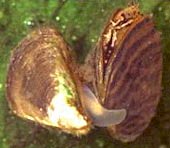Older stories on Resources News
Links to general resource, environmental sites
Links to non-profit environmental/resource groups
Links to environmental/resource news sources
E-mail Resources News
Error Suggested in Zebra Mussel Control Strategy
Since the zebra mussel first invaded North American waters in 1988, one of the key strategies for controlling their spread has been public information campaigns urging recreational boaters to clean the boats hull before transporting it to a different lake. The theory was that zebra mussels that had attached themselves to the boat's hull in infected waters would 'hitch a ride' to other lakes where new populations would be established. Recent research has suggested a serious flaw in that belief - although it still suggests that recreational boaters do play a key role in the spread of zebra mussels.
Ladd Johnson of Laval University in Quebec, Anthony Riccardi of McGill University in Montreal, and James Carlton of Williams College in Massachusetts examined the likelihood of recreational boats transporting the adult and larval stages of this invader. It had been assumed that mussel dispersal from boat launches occurred by direct attachment to transient boats. The researchers found that this is not the case.
"During the course of the study," Johnson says, "it became apparent that the conventional wisdom was wrong, and a previously unrecognized mechanism for the overland transport of zebra mussels existed. The transport of mussels attached to aquatic weeds called macrophytes that become entangled on boats or on boat trailers".
During the study, a total of 920 boaters were interviewed as they pulled their boats from the water at three popular public launches on Lake St. Clair near Detroit, one of the first lakes to be infected with zebra mussels. The boaters were asked questions pertaining to the duration of their outing, the activities and devices they used for fishing, whether they dropped anchor, and the anticipated time and location of the boat's next use.
A number of mechanisms of potential transport of zebra mussels were identified - attachment to the exterior of the boat, anchor, entangled aquatic weeds, engine cooling system, bilge water, live wells, and bait buckets. The latter four mechanisms have the potential to transport water containing the microscopic larval stage of the zebra mussel to other bodies of water.
The researchers found that zebra mussels were transported by all of these mechanisms - except direct attachment to the boat's exterior. There appears to be two reasons for this. First, most of the boats studied were in the water for a week or less. The longer a boat is left in a body of water, the greater the likelihood that direct attachment of zebra mussels may occur. Secondly, even if zebra mussels do attach themselves to the boat's hull, the authors concluded that they probably would not survive exposure to the air during transit.
The researchers also found zebra mussel larvae in every area where water is stored on a boat - the engine cooling system, bilge water, holding tanks and bait buckets. However, because of the low probability of establishing new populations from introductions of larvae, this is not thought to pose a significant risk.
From their data and information on out-of-water survival, the researchers estimate that a maximum of 12 of every 10,000 boaters who used the sampled boat launches transported live zebra mussels on entangled aquatic plants to inland waters. While this is a very small percentage, when the large number boats that are moved between lakes is taken into account, there is considerable potential for boats to transport live zebra mussels to other lakes and rivers. The researchers have predicted over 170 dispersal events from just one launch during the course of the summer.
In the past, boaters were told to sterilize the exterior surfaces of boats with chlorine solutions, hot water, or long periods out of the water. They have not been told to remove aquatic plants from their boats and trailers.
It has been suggested by some people that boat trailers are a significant risk, a risk that just washing may not overcome. The frames of most trailers are constructed of metal tubing which is open on the ends. When the trailer is backed into the water the tubing completely fills with water, moss, weeds, or whatever is in the area, including zebra mussel larvae or eggs. The water can still be running out hours later - and would likely still be in the trailer days later if it was parked somewhere. It doesn't require a lot of imagine to see how that could result in zebra mussels being transported from lake to lake.
The zebra mussel is damaging to both human infrastructure and natural ecosystems. Large groupings of the mussels clog pipes of power plants, water, and sewage treatment sites. The weight of mussels has even been known to sink buoys and navigational aids.
Ecologically, the mussels are adversely affecting native mussels by interfering with their feeding, growth, movement, respiration, and reproduction. Scientists have found that where zebra mussel densities are highest, the number of native mussels is dramatically lower than normal.
